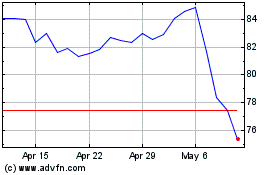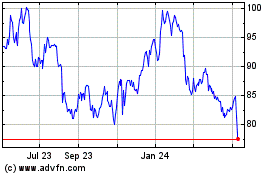Panasonic Scraps Revenue Goal
March 31 2016 - 9:10AM
Dow Jones News
TOKYO—Panasonic Corp. scrapped its ¥ 10 trillion ($89 billion)
revenue goal, citing a slowing Chinese economy and a continuing
commitment to pursue profit rather than just scale.
"The ¥ 10 trillion revenue was rather a symbolic flag to
encourage every member of Panasonic to think about how we should
achieve growth," Chief Executive Kazuhiro Tsuga said at a news
conference Thursday. But profit, he said, better reflects the
contribution to customers the company should focus on.
The goals he laid for the fiscal year ending March 2019— the
target year of the abandoned revenue goal, coinciding with the
company's 100th anniversary—are an operating profit of ¥ 500
billion and net profit of ¥ 250 billion. For the fiscal year just
ending, Panasonic expects an operating profit of ¥ 410 billion and
net profit of ¥ 180 billion, on ¥ 7.55 trillion in revenue.
When Mr. Tsuga took the top job in 2012, Panasonic was coming
off a net loss of ¥ 772 billion. He pledged to turn around the
Osaka-based electronics company by chopping off low-margin units
and nurturing profitable business-to-business enterprises. It was a
clear shift in strategy for Panasonic, which had been fighting
fiercely competitive South Korean rivals for market dominance in
consumer electronics. The company scaled back its flagship
television business and stopped selling smartphones.
That is why analysts and investors were puzzled when Mr. Tsuga
in 2014 mapped out the project to hit ¥ 10 trillion, a goal set
but not reached by some of his predecessors. It seemed like a
reversal for Mr. Tsuga, though he stressed at the time that the
added revenue should be accompanied by higher profits.
"If you want to just achieve ¥ 10 trillion goal, you could have
bought some unprofitable companies but with large revenue," said Yu
Okazaki, an analyst at Nomura Securities. The puzzlement might
partly explain why Panasonic's market cap falls short of that of
its closest rival, Sony Corp.—which was slower to fight bloat—¥ 2.5
trillion to ¥ 3.7 trillion.
"Withdrawing the stretched target should help investors look at
Panasonic's strategy more rationally," Mr. Okazaki said.
Challenges await Panasonic, but the company is on track for
growth, analysts say. The key is replicating the sort of success
enjoyed by its highly profitable U.S.-based Panasonic Avionics
unit, which sells airlines in-flight entertainment systems and
communication platforms connecting its cabin crews and ground
crews.
Among its recent initiatives, Panasonic is providing batteries
forTesla Motors Inc., joining the car maker in building a big
battery factory in the U.S., and has begun slowing expanding to
home batteries on its own. Last year it bought Hussmann Corp., a
U.S. maker of display cases and refrigeration systems for
retailers—a business in which Panasonic has a major presence in
Asia.
Panasonic is also pursuing opportunities in areas from security
cameras to advanced driver-assistance systems—perhaps too many
areas, analysts say.
"Panasonic planted many seeds of business and that's good, but
it may want to start picking up few best ones to focus on," said
Akie Iriyama, an associate professor at Waseda Business School.
In improving its business-to-business operation, Panasonic is
beefing up M&A to speed growth of promising business units such
as Avionics. Its efforts include hiring Eiichi Katayama, formerly a
top electronics analyst at Bank of America Merrill Lynch in Tokyo,
earlier this year. Mr. Katayama said in February that his job
includes advising Mr. Tsuga which business units to focus on.
Though the consumer market may not be as profitable as the
business market, Mr. Tsuga has been stressing its importance as a
source of stable profitability—a contrast to the approach of fellow
electronics giant Toshiba Corp., which gave up most of its
consumer-appliance businesses in trying to escape financial
troubles.
In Japan, Panasonic is a major provider of home appliances such
as refrigerators, rice cookers and even hair dryers. Its TV unit is
expected to turn a profit in the fiscal year ending Thursday—the
first in eight years.
Write to Takashi Mochizuki at takashi.mochizuki@wsj.com
(END) Dow Jones Newswires
March 31, 2016 08:55 ET (12:55 GMT)
Copyright (c) 2016 Dow Jones & Company, Inc.
Sony (NYSE:SONY)
Historical Stock Chart
From Mar 2024 to Apr 2024

Sony (NYSE:SONY)
Historical Stock Chart
From Apr 2023 to Apr 2024
